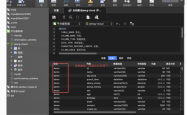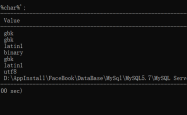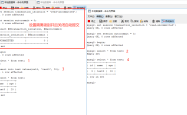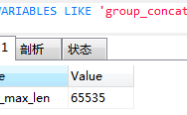mysql5.6主从搭建以及不同步问题详解
目录
- 一、mysql主从复制原理
- 二、mysql编译安装
- 三、主从配置
- 四、主从不同步
系统:centos6.6
主:192.168.142.129 mysql-5.6.30.tar.gz
从:192.168.142.130 192.168.142.131 mysql-5.6.30.tar.gz
一、mysql主从复制原理
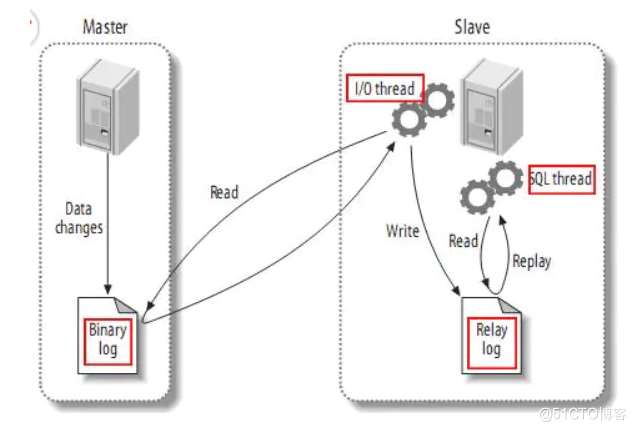
(1) master将改变记录到二进制日志(binary log)中;
(2) slave将master的binary log events拷贝到它的中继日志(relay log);slave的i/o线程从master的二进制日志中读取事件并写入中继日志;
(3) slave重做中继日志中的事件,将改变反映它自己的数据。slave的sql线程从中继日志读取事件,并在本地重放其中的事件,使其与master中的数据一致。
mysql主从实现的步骤:
1、使用mysqldump 命令备份数据库,
2、查看主节点二进制的位置点
3、创建备份用户,并授权(replication client.replication slave)
4、从服务器修改server-id,必须与主mysql的server-id不同,开启中继日子,关闭二进制日子
5、从数据库,倒入数据,并使用授权用户,连接主mysql
6、start slave
sql语言共分为以下几大类:查询语言dql,控制语言dcl,操纵语言dml,定义语言ddl。事务控制tcl.
dql(data query languages)语句:即数据库定义语句,用来查询select子句,from子句,where子句组成的查询块,比如:select–from–where–grouop by–having–order by–limit
ddl(data definition languages)语句:即数据库定义语句,用来创建数据库中的表、索引、视图、存储过程、触发器等,常用的语句关键字有create,alter,drop,truncate,comment,rename。增删改表的结构
dml(data manipulation language)语句:即数据操纵语句,用来查询、添加、更新、删除等,常用的语句关键字有:select,insert,update,delete,merge,call,explain plan,lock table,包括通用性的增删改查。增删改表的数据
dcl(data control language)语句:即数据控制语句,用于授权/撤销数据库及其字段的权限(dcl is short name of data control language which includes commands such as grant and mostly concerned with rights, permissions and other controls of the database system.)。常用的语句关键字有:grant,revoke。
tcl(transaction control language)语句:事务控制语句,用于控制事务,常用的语句关键字有:commit,rollback,savepoint,set transaction。
二、mysql编译安装
?| 1 2 3 4 5 6 7 8 9 10 11 12 13 14 15 16 17 18 19 20 21 22 23 24 25 26 27 28 29 30 31 32 33 34 35 36 37 38 39 40 41 42 43 44 45 46 47 48 49 50 51 52 53 54 55 56 57 58 59 60 61 62 63 64 65 66 67 68 69 70 71 72 73 74 75 76 77 78 79 80 81 82 83 84 85 86 87 88 89 90 91 92 93 94 95 96 97 98 99 100 101 102 103 104 105 106 107 108 109 110 111 112 113 114 115 116 117 118 119 120 121 122 123 124 125 126 127 128 129 130 131 132 133 134 135 136 137 138 139 140 141 142 143 144 145 146 147 148 149 150 151 152 153 154 155 156 157 158 159 160 161 162 163 164 165 166 167 168 169 170 171 172 173 174 175 176 177 178 179 180 181 182 183 184 185 186 187 188 189 190 191 192 193 194 195 196 197 198 199 200 201 202 203 204 205 206 207 208 209 210 211 212 213 214 215 216 217 218 219 220 221 222 223 224 225 226 227 228 229 230 231 232 233 234 235 236 237 238 239 240 241 242 243 244 245 246 247 248 249 250 251 252 253 254 255 256 257 258 259 260 261 262 263 264 265 266 267 268 269 270 271 272 273 274 275 276 277 278 279 280 281 282 283 284 285 286 287 288 289 290 291 292 293 294 295 296 297 298 299 300 301 302 303 304 305 306 307 308 309 310 311 312 313 314 315 316 317 318 319 320 321 322 323 324 325 326 327 328 329 330 331 332 333 334 335 336 337 338 339 340 341 342 343 344 345 346 347 348 349 350 351 352 353 354 355 356 357 358 359 360 361 362 363 364 365 366 367 368 369 370 371 372 373 374 375 376 377 378 379 380 381 382 383 384 385 386 387 388 389 390 391 392 393 394 395 396 397 398 399 400 401 402 403 404 405 406 407 408 409 410 411 412 413 414 415 416 417 418 419 420 421 422 423 424 425 426 427 428 429 430 431 432 433 434 435 436 437 438 439 440 441 442 443 444 445 446 447 448 449 450 451 452 453 454 455 456 457 458 459 460 461 462 463 464 465 466 467 468 469 470 471 472 473 474 475 476 477 478 479 480 481 482 483 484 485 486 487 488 489 490 491 492 493 494 495 496 497 498 499 500 501 502 503 504 505 506 507 508 509 510 511 | #!/bin/bash yum -y install make gcc gcc-c++ openssl openssl-devel pcre-devel gd cmake ncurses ncurses-devel id -u mysql if [ `echo $?` -ne 0 ]; then groupadd mysql useradd -m -g mysql -s /sbin/nologin mysql fi if [ ! -d "/usr/local/mysql" ]; then mkdir -p /usr/ local /mysql fi mkdir -p /data/mysql chown -r mysql:mysql /data/mysql cd /home/soft/ #软件存放目录 tar zxvf mysql-5.6.30.tar.gz cd mysql-5.6.30 cmake -dcmake_install_prefix=/usr/ local /mysql -dsysconfdir=/etc -dmysql_datadir=/data/mysql/data -dinstall_mandir=/usr/share/man -dmysql_tcp_port=3306 -dmysql_unix_addr=/tmp/mysql.sock -ddefault_charset=utf8 -dextra_charsets= all -ddefault_collation=utf8_general_ci -dwith_readline=1 -dwith_ssl=system -dwith_embedded_server=1 -denabled_local_infile=1 -dwith_innobase_storage_engine=1 make && make install chown -r mysql:mysql . chmod +x scripts/mysql_install_db ./scripts/mysql_install_db --user=mysql --basedir=/usr/local/mysql --datadir=/data/mysql cp ./support-files/mysql.server /etc/rc.d/init.d/mysqld chmod 755 /etc/init.d/mysqld chkconfig mysqld on cat> /etc/rc.d/init.d/mysqld << 'eof' #mysql启动脚本 #!/bin/sh # copyright abandoned 1996 tcx datakonsult ab & monty program kb & detron hb # this file is public domain and comes with no warranty of any kind # mysql daemon start/stop script. # usually this is put in /etc/init.d ( at least on machines sysv r4 based # systems) and linked to /etc/rc3.d/s99mysql and /etc/rc0.d/k01mysql. # when this is done the mysql server will be started when the machine is # started and shut down when the systems goes down. # comments to support chkconfig on redhat linux # chkconfig: 2345 64 36 # description: a very fast and reliable sql database engine. # comments to support lsb init script conventions ### begin init info # provides: mysql # required-start: $local_fs $network $remote_fs # should-start: ypbind nscd ldap ntpd xntpd # required-stop: $local_fs $network $remote_fs # default -start: 2 3 4 5 # default -stop: 0 1 6 # short-description: start and stop mysql # description: mysql is a very fast and reliable sql database engine. ### end init info # if you install mysql on some other places than /usr/ local /mysql, then you # have to do one of the following things for this script to work : # # - run this script from within the mysql installation directory # - create a /etc/my.cnf file with the following information: # [mysqld] # basedir=<path- to -mysql-installation-directory> # - add the above to any other configuration file ( for example ~/.my.ini) # and copy my_print_defaults to /usr/bin # - add the path to the mysql-installation-directory to the basedir variable # below. # # if you want to affect other mysql variables, you should make your changes # in the /etc/my.cnf, ~/.my.cnf or other mysql configuration files. # if you change base dir, you must also change datadir. these may get # overwritten by settings in the mysql configuration files. basedir=/usr/ local /mysql datadir=/data/mysql # default value, in seconds, afterwhich the script should timeout waiting # for server start. # value here is overriden by value in my.cnf. # 0 means don 't wait at all # negative numbers mean to wait indefinitely service_startup_timeout=900 # lock directory for redhat / suse. lockdir=' /var/lock/subsys ' lock_file_path="$lockdir/mysql" # the following variables are only set for letting mysql.server find things. # set some defaults mysqld_pid_file_path= if test -z "$basedir" then basedir=/usr/local/mysql bindir=/usr/local/mysql/bin if test -z "$datadir" then datadir=/data/mysql/data fi sbindir=/usr/local/mysql/bin libexecdir=/usr/local/mysql/bin else bindir="$basedir/bin" if test -z "$datadir" then datadir="$basedir/data" fi sbindir="$basedir/sbin" libexecdir="$basedir/libexec" fi # datadir_set is used to determine if datadir was set (and so should be # *not* set inside of the --basedir= handler.) datadir_set= # use lsb init script functions for printing messages, if possible # lsb_functions="/lib/lsb/init-functions" if test -f $lsb_functions ; then . $lsb_functions else log_success_msg() { echo " success! $@" } log_failure_msg() { echo " error! $@" } fi path="/sbin:/usr/sbin:/bin:/usr/bin:$basedir/bin" export path mode=$1 # start or stop [ $# -ge 1 ] && shift other_args="$*" # uncommon, but needed when called from an rpm upgrade action # expected: "--skip-networking --skip-grant-tables" # they are not checked here, intentionally, as it is the resposibility # of the "spec" file author to give correct arguments only. case `echo "testing\c"`,`echo -n testing` in *c*,-n*) echo_n= echo_c= ;; *c*,*) echo_n=-n echo_c= ;; *) echo_n= echo_c=' \c ' ;; esac parse_server_arguments() { for arg do case "$arg" in --basedir=*) basedir=`echo "$arg" | sed -e ' s/^[^=]*=// '` bindir="$basedir/bin" if test -z "$datadir_set"; then datadir="$basedir/data" fi sbindir="$basedir/sbin" libexecdir="$basedir/libexec" ;; --datadir=*) datadir=`echo "$arg" | sed -e ' s/^[^=]*=// '` datadir_set=1 ;; --pid-file=*) mysqld_pid_file_path=`echo "$arg" | sed -e ' s/^[^=]*=// '` ;; --service-startup-timeout=*) service_startup_timeout=`echo "$arg" | sed -e ' s/^[^=]*=// '` ;; esac done } wait_for_pid () { verb="$1" # created | removed pid="$2" # process id of the program operating on the pid-file pid_file_path="$3" # path to the pid file. i=0 avoid_race_condition="by checking again" while test $i -ne $service_startup_timeout ; do case "$verb" in ' created ') # wait for a pid-file to pop into existence. test -s "$pid_file_path" && i=' ' && break ;; ' removed ') # wait for this pid-file to disappear test ! -s "$pid_file_path" && i=' ' && break ;; *) echo "wait_for_pid () usage: wait_for_pid created|removed pid pid_file_path" exit 1 ;; esac # if server isn' t running, then pid-file will never be updated if test -n "$pid" ; then if kill -0 "$pid" 2>/dev/ null ; then : # the server still runs else # the server may have exited between the last pid-file check and now. if test -n "$avoid_race_condition" ; then avoid_race_condition= "" continue # check again. fi # there 's nothing that will affect the file. log_failure_msg "the server quit without updating pid file ($pid_file_path)." return 1 # not waiting any more. fi fi echo $echo_n ".$echo_c" i=`expr $i + 1` sleep 1 done if test -z "$i" ; then log_success_msg return 0 else log_failure_msg return 1 fi } # get arguments from the my.cnf file, # the only group, which is read from now on is [mysqld] if test -x ./bin/my_print_defaults then print_defaults="./bin/my_print_defaults" elif test -x $bindir/my_print_defaults then print_defaults="$bindir/my_print_defaults" elif test -x $bindir/mysql_print_defaults then print_defaults="$bindir/mysql_print_defaults" else # try to find basedir in /etc/my.cnf conf=/etc/my.cnf print_defaults= if test -r $conf then subpat=' ^[^=]*basedir[^=]*=\(.*\)$ ' dirs=`sed -e "/$subpat/!d" -e ' s//\1/ ' $conf` for d in $dirs do d=`echo $d | sed -e ' s/[ ]//g '` if test -x "$d/bin/my_print_defaults" then print_defaults="$d/bin/my_print_defaults" break fi if test -x "$d/bin/mysql_print_defaults" then print_defaults="$d/bin/mysql_print_defaults" break fi done fi # hope it' s in the path ... but i doubt it test -z "$print_defaults" && print_defaults= "my_print_defaults" fi # # read defaults file from 'basedir' . if there is no defaults file there # check if it 's in the old (depricated) place (datadir) and read it from there # extra_args="" if test -r "$basedir/my.cnf" then extra_args="-e $basedir/my.cnf" else if test -r "$datadir/my.cnf" then extra_args="-e $datadir/my.cnf" fi fi parse_server_arguments `$print_defaults $extra_args mysqld server mysql_server mysql.server` # # set pid file if not given # if test -z "$mysqld_pid_file_path" then mysqld_pid_file_path=$datadir/`hostname`.pid else case "$mysqld_pid_file_path" in /* ) ;; * ) mysqld_pid_file_path="$datadir/$mysqld_pid_file_path" ;; esac fi case "$mode" in ' start ') # start daemon # safeguard (relative paths, core dumps..) cd $basedir echo $echo_n "starting mysql" if test -x $bindir/mysqld_safe then # give extra arguments to mysqld with the my.cnf file. this script # may be overwritten at next upgrade. $bindir/mysqld_safe --datadir="$datadir" --pid-file="$mysqld_pid_file_path" $other_args >/dev/null 2>&1 & wait_for_pid created "$!" "$mysqld_pid_file_path"; return_value=$? # make lock for redhat / suse if test -w "$lockdir" then touch "$lock_file_path" fi exit $return_value else log_failure_msg "couldn' t find mysql server ($bindir/mysqld_safe)" fi ;; 'stop' ) # stop daemon. we use a signal here to avoid having to know the # root password . if test -s "$mysqld_pid_file_path" then mysqld_pid=`cat "$mysqld_pid_file_path" ` if (kill -0 $mysqld_pid 2>/dev/ null ) then echo $echo_n "shutting down mysql" kill $mysqld_pid # mysqld should remove the pid file when it exits, so wait for it. wait_for_pid removed "$mysqld_pid" "$mysqld_pid_file_path" ; return_value=$? else log_failure_msg "mysql server process #$mysqld_pid is not running!" rm "$mysqld_pid_file_path" fi # delete lock for redhat / suse if test -f "$lock_file_path" then rm -f "$lock_file_path" fi exit $return_value else log_failure_msg "mysql server pid file could not be found!" fi ;; 'restart' ) # stop the service and regardless of whether it was # running or not , start it again. if $0 stop $other_args; then $0 start $other_args else log_failure_msg "failed to stop running server, so refusing to try to start." exit 1 fi ;; 'reload' | 'force-reload' ) if test -s "$mysqld_pid_file_path" ; then read mysqld_pid < "$mysqld_pid_file_path" kill -hup $mysqld_pid && log_success_msg "reloading service mysql" touch "$mysqld_pid_file_path" else log_failure_msg "mysql pid file could not be found!" exit 1 fi ;; 'status' ) # first , check to see if pid file exists if test -s "$mysqld_pid_file_path" ; then read mysqld_pid < "$mysqld_pid_file_path" if kill -0 $mysqld_pid 2>/dev/ null ; then log_success_msg "mysql running ($mysqld_pid)" exit 0 else log_failure_msg "mysql is not running, but pid file exists" exit 1 fi else # try to find appropriate mysqld process mysqld_pid=`pidof $libexecdir/mysqld` if test -z $mysqld_pid ; then if test -f "$lock_file_path" ; then log_failure_msg "mysql is not running, but lock file ($lock_file_path) exists" exit 2 fi log_failure_msg "mysql is not running" exit 3 else log_failure_msg "mysql is running but pid file could not be found" exit 4 fi fi ;; *) # usage basename=`basename "$0" ` echo "usage: $basename {start|stop|restart|reload|force-reload|status} [ mysql server options ]" exit 1 ;; esac exit 0 eof cat> /etc/my.cnf << 'eof' #mysql配置文件 [client] # password = your_password port = 3306 socket = /tmp/mysql.sock # here follows entries for some specific programs # the mysql server [mysqld] port = 3306 socket = /tmp/mysql.sock skip-external-locking key_buffer_size = 384m max_allowed_packet = 64m table_open_cache = 512 sort_buffer_size = 2m read_buffer_size = 2m read_rnd_buffer_size = 8m myisam_sort_buffer_size = 64m thread_cache_size = 8 query_cache_size = 32m # try number of cpu 's*2 for thread_concurrency thread_concurrency = 8 basedir = /usr/local/mysql datadir = /data/mysql max_connections = 5000 long_query_time = 1 slow_query_log = 1 slow_query_log_file = /var/log/mysql/slow.log # don' t listen on a tcp/ip port at all . this can be a security enhancement, # if all processes that need to connect to mysqld run on the same host. # all interaction with mysqld must be made via unix sockets or named pipes. # note that using this option without enabling named pipes on windows # (via the "enable-named-pipe" option ) will render mysqld useless! lower_case_table_names = 1 # replication master server ( default ) # binary logging is required for replication #log-bin=mysql-bin skip- name -resolve # required unique id between 1 and 2^32 - 1 # defaults to 1 if master-host is not set # but will not function as a master if omitted #server-id = 1 # binary logging - not required for slaves, but recommended #log-bin=mysql-bin # # binary logging format - mixed recommended #binlog_format=mixed # uncomment the following if you are using innodb tables #innodb_data_home_dir = /data/mysql/data #innodb_data_file_path = ibdata1:2000m;ibdata2:10m:autoextend #innodb_log_group_home_dir = /data/mysql/data # you can set .._buffer_pool_size up to 50 - 80 % # of ram but beware of setting memory usage too high innodb_buffer_pool_size = 4096m #innodb_additional_mem_pool_size = 20m # set .._log_file_size to 25 % of buffer pool size innodb_log_file_size = 512m #innodb_log_buffer_size = 8m innodb_flush_log_at_trx_commit = 0 #innodb_lock_wait_timeout = 50 [mysqldump] quick max_allowed_packet = 64m [mysql] no -auto-rehash # remove the next comment character if you are not familiar with sql #safe-updates [myisamchk] key_buffer_size = 256m sort_buffer_size = 256m read_buffer = 2m write_buffer = 2m [mysqlhotcopy] interactive-timeout eof ln -s /usr/ local /mysql/bin/mysqladmin /usr/bin ln -s /usr/ local /mysql/lib/mysql /usr/lib ln -s /usr/ local /mysql/include/mysql /usr/include/mysql mkdir /var/lib/mysql ln -s /tmp/mysql.sock /var/lib/mysql/mysql.sock echo 'export path=$path:/usr/local/mysql/bin' >> /etc/profile sleep 2 source /etc/profile service mysqld start sleep 5 cd /usr/ local /mysql/bin && mysqladmin -uroot password 'mysql' #授权root用户的 password source /etc/profile |
三、主从配置
1、这里验证主库有数据的情况,然后授权有复制权限的用户
?| 1 2 3 4 5 6 7 | mysql> create database db1; mysql> use db1 mysql> create table t1(id int , name varchar (12)); mysql> insert into t1 values (1, 'tom' ), (2, 'jerry' ), (3, 'jack' ); mysql> grant replication slave,replication client on *.* to 'backuser' @ '192.168.142.130' identified by 'mysqll' ; mysql> grant replication slave,replication client on *.* to 'backuser' @ '192.168.142.131' identified by 'mysql' ; mysql> flush privileges ; |
2、修改各个数据库的配置文件后重启数据库
?| 1 2 3 4 5 6 7 8 9 10 11 12 13 14 | vi /etc/my.cnf #主库配置文件 server-id=1 log-bin=mysql-bin binlog-do-db=db1 binlog- ignore -db=mysql vi /etc/my.cnf #从库配置文件 server-id=2 #从库id不能和主库一样,其他从库往后面排 log-bin=relay-bin replicate-do-db=db1 #同步db1库 replicate- ignore -db=mysql #不会同步mysql库 read_only #只读 service mysqld restart |
3、主库锁表备份,然后文件传给从库
?| 1 2 3 4 5 6 7 | mysql> flush tables with read lock; #主库锁表防止新的数据写入 mysql> show master status; #查看主库位置节点 新打开一个终端备份: mysqldump -u root -p --default-character-set=utf8 --opt -q -r --skip-lock-tables db1 > /root/db1.sql scp /root/db1.sql root@192.168.142.130:/root scp /root/db1.sql root@192.168.142.130:/root |
4、从库导入数据,然后change到主库的节点
?| 1 2 3 4 5 6 7 | mysql -u root -p mysql> create database db1; mysql> use db1 mysql> source /root/db1.sql mysql> change master to master_host= '192.168.142.129' ,master_user= 'backuser' ,master_password= 'mysql' ,master_log_file= 'mysql-bin.000001' ,master_log_pos=120; mysql> start slave; mysql> show slave status\g |
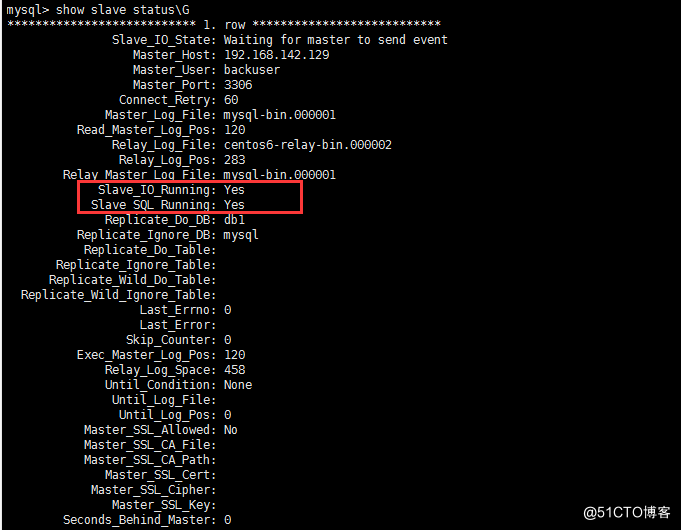
5、主库解锁
mysql> unlock tables;
以上配置对主从不同步,重新配置主从同样适用。
四、主从不同步
1、造成不同步的原因
网络的延迟主从两台机器的负载不一致max_allowed_packet设置不一致key自增键开始的键值跟自增步长设置不一致引起的主从不一致mysql异常宕机情况下,如果未设置sync_binlog=1或者innodb_flush_log_at_trx_commit=1很有可能
出现binlog或者relaylog文件出现损坏,导致主从不一致mysql本身的bug引起的主从不同步版本不一致,特别是高版本是主,低版本为从的情况下,主数据库上面支持的功能,从数据库上面不支持该功能
2、解决办法
(1)忽略错误后,继续同步
该方法适用于主从库数据相差不大,或者要求数据可以不完全统一的情况,数据要求不严格的情况
?| 1 | stop slave; set global sql_slave_skip_counter =1; start slave; show slave status\g |
(2)重新做主从
参考上面配置主库锁表重新做主从。
到此这篇关于mysql5.6主从搭建以及不同步问题详解的文章就介绍到这了,更多相关mysql主从搭建和不同步内容请搜索服务器之家以前的文章或继续浏览下面的相关文章希望大家以后多多支持服务器之家!
原文链接:https://blog.51cto.com/qidian510/4735249
1.本站遵循行业规范,任何转载的稿件都会明确标注作者和来源;2.本站的原创文章,请转载时务必注明文章作者和来源,不尊重原创的行为我们将追究责任;3.作者投稿可能会经我们编辑修改或补充。


